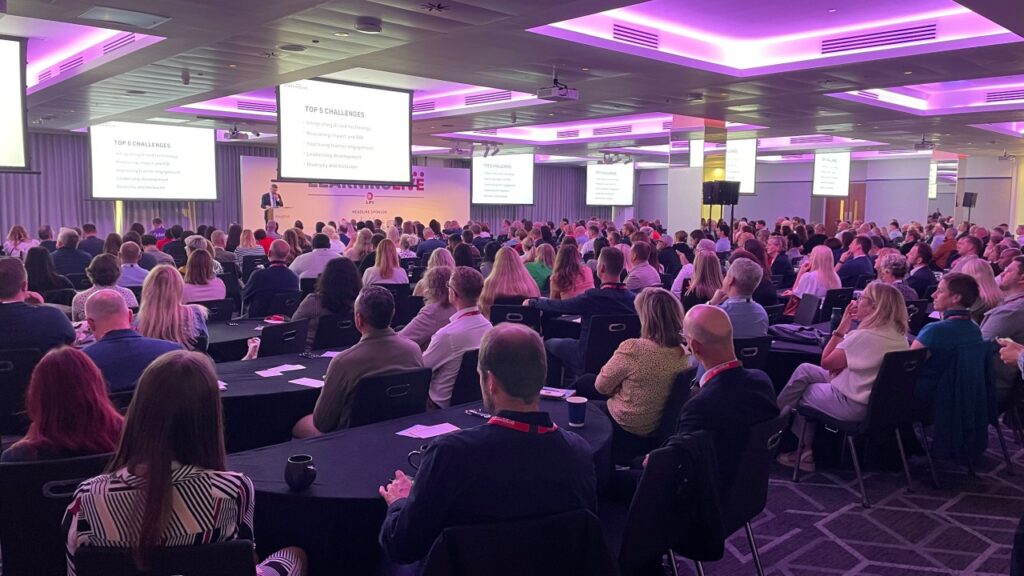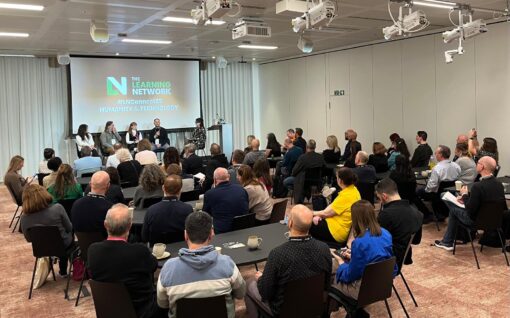Learning Live 2024: Talking tasks

There was always going to be a lot said about AI at Learning Live 2024. Each year, the conference agenda is created from the challenges reported by the heads of learning signed up for the event and this year, AI integration was the number one challenge. It was followed by ROI and impact measurement, engagement, leadership development and diversity and inclusion.
I attended three talks on AI, one that covered the bigger societal picture (more on that here), another the impact on learning and the third, a more granular-level look at AI through the use of Copilot at Microsoft. There were many common themes but the one that really stood out was work tasks. AI strategist Jon Fletcher told delegates that AI is a catalyst for change, but to harness it effectively L&D needs to focus on tasks first, rather than looking for an AI solution to deliver on the learning team’s goals.
“We’re trying to work out how to use AI, but we’re focusing on it from an AI technology perspective, not from a task perspective. We’re not focusing on how we are doing our day-to-day flow of work, our day-to-day tasks. Yet we’re trying to get a piece of technology and trying to fit it into our flow of work, instead of focusing the other way. To understand how to drive performance, you need to identify which tasks we need to adopt for ourselves and which ones to augment with AI.”
He also made an interesting point about AI skills. He says that employees need to be able to use AI tools so that they can learn how these tools can improve their performance. That’s the way to get adoption and is something L&D teams could be supporting now.
Not surprisingly, that’s exactly what’s happening at Microsoft. The company encouraged staff to experiment with AI (and its AI Copilot product) to identify use cases for the technology. This helped create interest in using AI and has led to numerous use cases that have been used internally and with customers.
Microsoft’s approach to AI and learning is to first understand the tasks that need to be done and then to figure out which tasks will be automated and which ones will be carried out by humans. This will determine what work looks like and this will determine what learning will be needed to support people in their work.
Simon Lambert, chief learning officer at Microsoft UK, said, “Copilot is fundamentally changing the way we approach tasks. It is disrupting how we’re learning and making us think differently about skills and how those skills need to be developed in the workplace.
“So when you start thinking about what the challenges are that you face specifically around certain tasks, around certain functions, you can start to map out process flows for that, and then you can start to use Copilot to interject at certain points across that process, which then effectively removes some of the tasks you would traditionally have to think about. This is changing the way that we approach problems and address issues in the organisation. This challenges the way which we think about traditional learning.”
This approach to tasks, work and learning matters when you consider that 302,000 organisations in the UK use Office 365, according to Statista.
If organisations have Copilot on every device, it follows that they will increasingly use the technology to automate tasks and support employees in more complex tasks. So, Microsoft’s approach could have a significant impact on tasks and redefining work, skills and learning.
Away from the AI discussions, Kenny Temowo, who is responsible for leadership, culture and talent development at Netflix, shared how the company approaches leadership development. He asked a great question: “If leadership is the answer, what is the question?” For Netflix, the answer is responsibility. It wants what it calls “unusually responsible leaders”.
Aside from their functional responsibilities, Netflix wants leaders to build “dream teams” and to model the Netflix culture.
The Netflix culture does grab attention, from its Keeper test to the ‘no brilliant jerks’ rule, the company has had eye-catching approaches to building talent.
The keeper test was born out of the Co—Founder of Netflix, Reed Hastings’ desire to have the right person in the right role and at the right time. That means creating teams of high performers, who are curious and prepared to take risks and have a diversity of strengths. For team members it means seeking out and providing feedback, being candid and being accountable. And this needs trust, says Temowo,
The result? A culture that encourages freedom and responsibility and that delivers creativity. Creating the right culture for creativity is critical for Netflix. “Our culture is our North Star,” Temowo adds.
When it comes to building leadership development, Netflix focuses on:
· Show rather than tell – get leaders to test what you are doing before you share it more widely
· Move from topics to challenges
· Make it real, relevant and memorable – how can leaders use what they have learned?
· Seek to inspire – craft great stories that provide a shared language
· Find a way to hold up a mirror to your leader eg customer voice
· Provide toolkits to the team
· Ensure your audience is deeply involved in the process
I also attended a panel on embracing diversity and inclusion, a topic that seems more pressing than ever following the recent violence against asylum seekers after the death of three girls in Southport in the UK this summer.
Yasmine Alani FLPI, head of creative learning, DEI and culture at MediaZoo, told delegates that it was now time to change the narrative on diversity and inclusion.
“We all know what it feels like on some level to be excluded, right? We have to change the narrative because what we’re seeing is a very dangerous narrative in the DEI space. There’ almost an anti-DEI movement. We all saw what Elon Musk said – that DEI must DIE – and that is shocking. We have very senior people and senior thought leaders rebelling against DEI, and this is because they don’t feel that inclusion is for them. In the first place we need to change the narrative on DEI, from it’s about this group of people to it’s about everybody.”
As well as making the case for inclusion, panellists also shared ideas on how to engage individuals and the whole organisation around inclusion. These included:
· Making inclusion everyone’s responsibility by encouraging all employees, not just leaders, to participate in DEI initiatives.
· Changing the narrative to emphasise that inclusion benefits everyone, not just those who are excluded.
· Meet people where they are by having discussions and providing support based on individuals’ needs and engagement levels.
· Leading by example and ensuring leaders demonstrate their commitment to inclusion.
· Focusing on culture to move away from diversity targets to creating positive, inclusive experiences for all employees.
· Creating safe spaces to foster environments where everyone feels heard, valued, and can express themselves without fear.
This final point was summed up by panellist Sarah Burrell, an equity, inclusion and culture specialist, who said, “I have got a speech impairment so don’t be afraid. I was a bit anxious today but what’s really important for me is being here with this panel and giving myself a platform, which a lot of people in my position don’t do because they are afraid of what people think. In my experience, having a disability and having the confidence to be in this meeting, it exposes people to what’s different about me and what I can bring to it. It is really important to fight through the nerves because having a voice is really important.”
Diversity and inclusion, leadership, culture, technology and impact. The five challenges shaping this year’s Learning Live might seem mutually exclusive, but the conference sessions highlighted some common threads – that technology is fundamentally changing what work tasks and learning will look like, that leadership and culture are critical factors in leading organisations through this technological change successfully and that all individuals want to know what this means for their skills and roles now and into the future. Within all this there is the challenge of voice and impact for learning leaders. Articulating these challenges and how L&D can help organisations overcome them is becoming more pressing than ever.
- I also shared a post about the focus on performance at the event , which you can read here. The comments are very interesting so thanks to all those who added their thoughts.
Picture credit: The LPI

